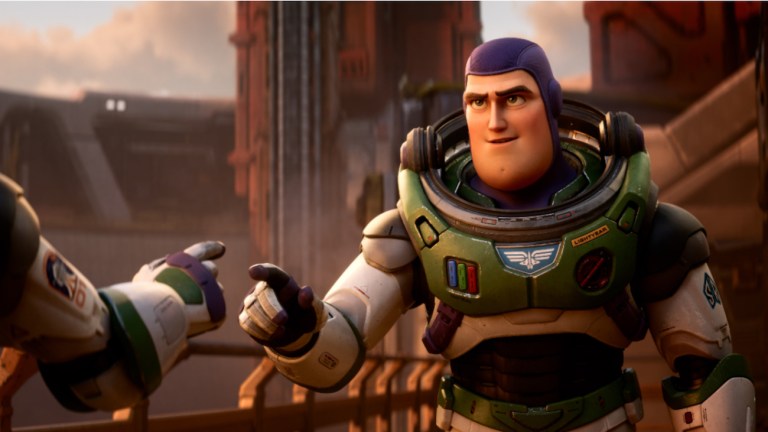Lightyear Review: Pixar at Its Most Visually Eye-Popping
Lightyear might see Pixar leaning toward the conventional, but the amount of heart and visual splendor at work makes this a successful maiden voyage to infinity and beyond.

Lightyear is a movie that no one asked for, an odd spin-off of a beloved movie franchise that many felt should finally be put up on the shelf for good. But as they’ve done many times before, Pixar has taken a seemingly ill-conceived concept and proven that the weirdest ideas are often some of the best ones.
The secret to Lightyear’s success is that it stands on its own. The clever opening text explains that this is the movie that Andy’s Buzz Lightyear toy was based on, which is useful in that it places it neatly within the Toy Story universe but also frees it up to tell its own adventure without having to be shackled to the plots of the original movies. It’s a fiction within a fiction, which is a lot of fun.
The truth is Lightyear doesn’t feel like a spin-off at all. It’s a thrilling, heartfelt, genuinely funny sci-fi adventure with its own art style and tone, and a hero we’ve actually never met before.
Chris Evans stars as intrepid space ranger Buzz Lightyear. While he’s got a few of the same catchphrases and idiosyncrasies of the original, plasticky Buzz, his personality and journey are wholly unique. He and his commander/best friend Alisha Hawthorne (Uzo Aduba) are a great team on the field as space rangers, exploring new planets and surviving angry alien monster attacks side by side. But Buzz is short on patience for rookies and has a tendency to carry too much responsibility on his shoulders.
When Buzz accidentally crash lands his colony’s space ark on a hostile alien planet, he vows to fix his mistake by attempting to engineer a sufficiently powerful crystal to fuel his ship and reach hyperspeed by slingshotting around a star…or something. It’s a bit vague, but the point is, with each attempt, he jumps forward in time several years. After way too many failed attempts, he finds himself decades in the future, fighting off the evil Emperor Zurg and his army of robot minions alongside a robot cat named Sox (Peter Sohn), and as fate would have it, a group of clueless rookies, led by Alisha’s granddaughter Izzy (Keke Palmer).
The story revolves around the idea of living in the present and not being haunted by the past and future, with Buzz learning the hard way to trust others. It isn’t Pixar’s most inspired story by a long shot, but the emotional beats are powerful enough to break up the action, and the dialogue consistently hits the mark. It’s also worth mentioning that Sox is essentially a single joke repeated incessantly, and it somehow never gets old. If all computers made inexplicable cat noises as they ran their calculations, the world would be a better place.
Evans as Buzz was a good choice—he obviously has experience playing a dutiful, hardened soldier who softens over time. Palmer plays a good sidekick, but the real standout is Taika Watiti as the butterfingered Mo, who manages to bungle virtually every task he’s given, which drives Buzz to the brink of madness. The cast has a good rapport, but nothing quite as magical as the banter bouncing around Andy’s room for all those years.
Pixar’s visuals have been consistently tremendous since the studio’s inception, but it’s easy these days to take for granted just how ridiculously amazing the animators and artists’ handiwork is, especially on smaller-scale, stylized pictures like Luca and Turning Red. But with Lightyear, there is absolutely zero fronting on how fantastic it looks. This is the most eye-popping Pixar movie ever.
The lighting, character, and art design are all great, but what’s really mind blowing is the sheer scope and level of detail of the CGI. During the jaw-dropping space flight sequences, the way light bounces around the cockpit and Buzz’s helmet as he hurtles through the vastness of space looks so hyper-realistic that it demands to be seen on the big screen. And even the smallest details—like how Buzz’s microwaveable space food jiggles in its tray, or the way Sox’s fur bends around Buzz’s fingers—look incredible. Pixar let their artists go all-out here, and the movie feels like a true mega-budget action blockbuster.
Of course action sequences aren’t foreign to the Pixar crew by any means, and they really flex their muscles this time around with explosive, heart-pumping set pieces that are worth the price of admission. The space travel scenes are exhilarating, especially in IMAX (the aspect ratio expands whenever Buzz climbs into the cockpit). And one scene near the end of the film captures the terror of the emptiness of space so well that it’ll make you grip your armrest extra tight.
Lightyear is maybe the most conventional movie Pixar has ever made, but in a catalog full of high-concept, poetic, borderline art films, this feels like a charming respite. It’s an epic adventure with exhilarating action sequences that are elevated greatly by bleeding edge visuals, and this new Buzz is impossibly just as interesting as the old one. The ending seems to suggest a sequel could be coming down the line, and considering how entertaining this maiden flight was, a second voyage to infinity and beyond seems likely.
Lightyear opens only in theaters on Friday, June 17.
